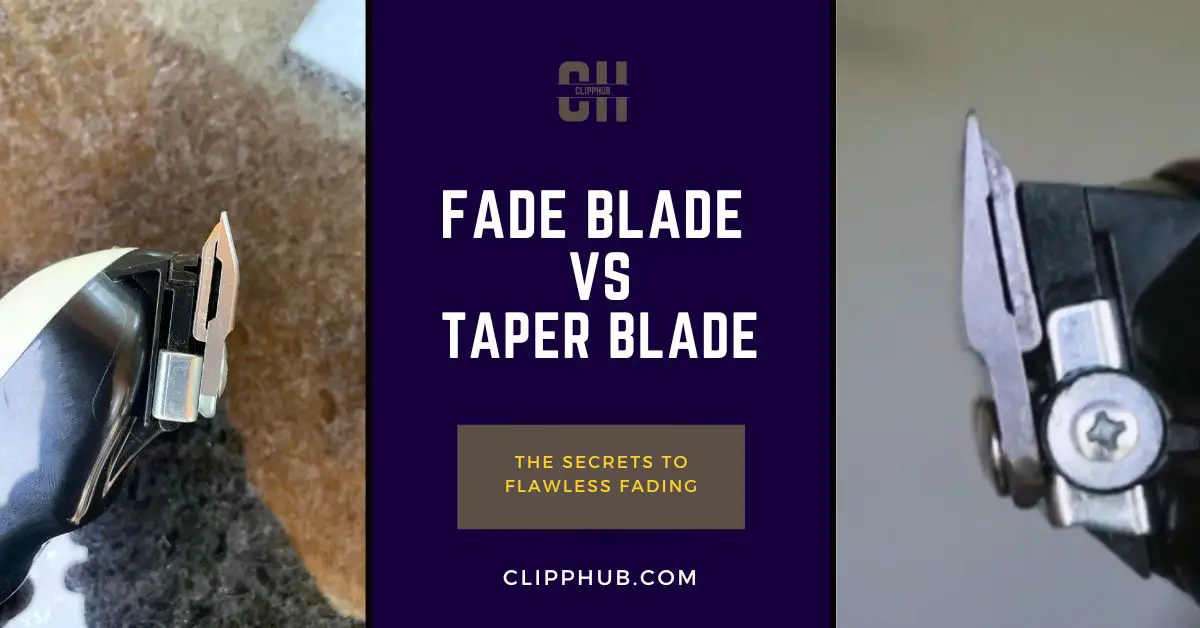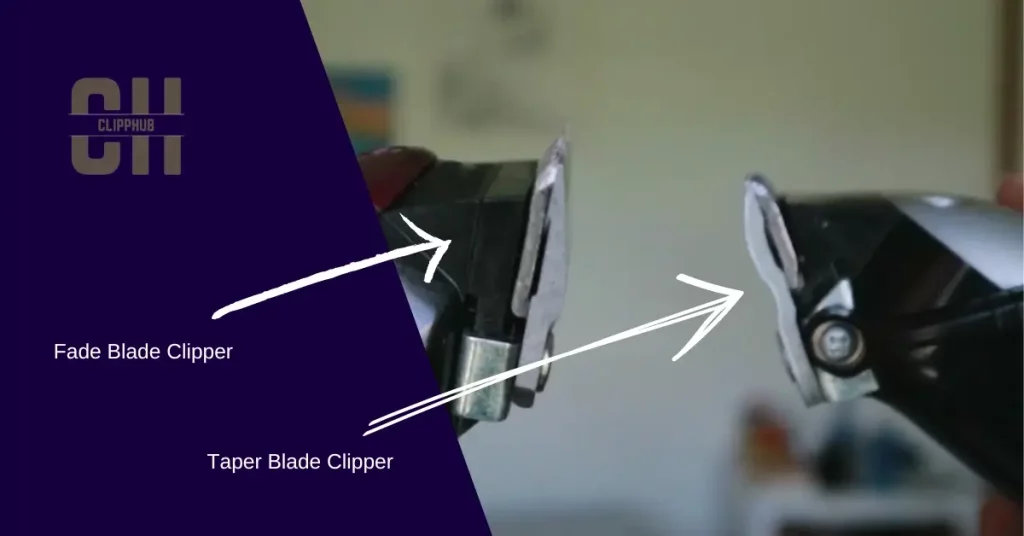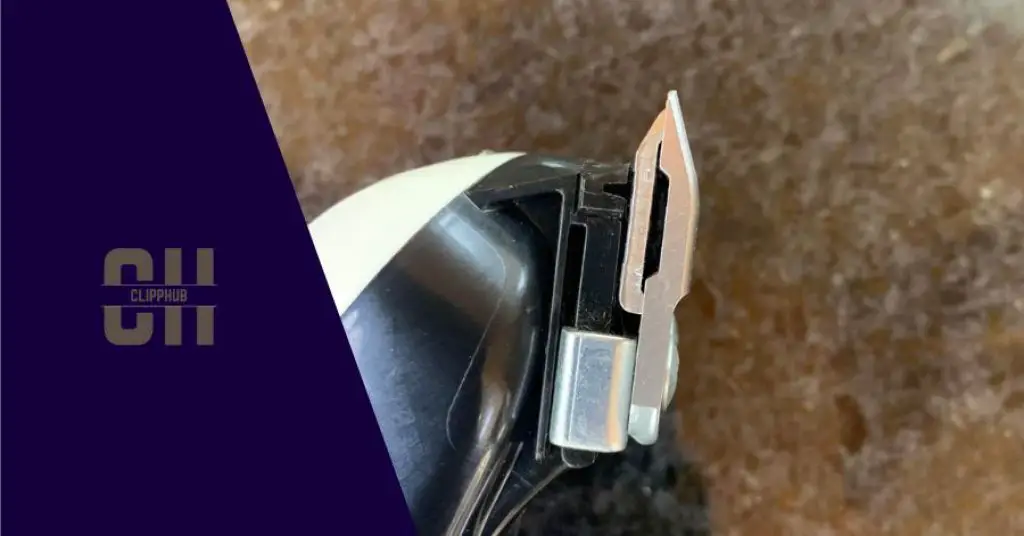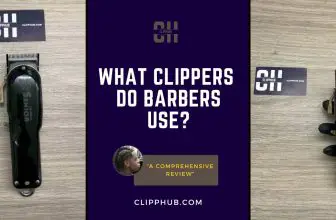
A lot has been said recently about the fade blade vs taper blade.
If you’re new to using clippers or are just curious about the topic, in this post, we’ll go over the key differences between a fade and taper blade.
You’ll learn what they cut to and why it may be best to have both in your toolkit…. and we’ll go over the new type of blade that gets the best of both worlds.
All questions are answered in this article.
So with that said, let’s get into it.
Fade blade vs taper blade
So what exactly is a fade blade and what is a taper blade?

When we talk about the fade blade vs the taler blade, we’re talking about the bigger guard blade on the back of your clippers.
Fade vs Taper Blade

Now, the main difference between a fade blade and a taper blade comes down to the shape and length of the blade.
As you can see from the image above, both blades are slightly different.
A fade blade is flat and thin with a heel at the base.
But the tapered blade is curved out and slightly thicker with no heel.
A fade blade is ideal for creating close and precise cuts.
It’s best used for taking out the bald/bald fades with no guards and overall it cuts to the ‘true length’ – we’ll talk more about this later.
On the other hand, the tapered blade is better suited to creating gradual and forgiving fades.
It’s built to suit the scooping/ rocking motion needed for fading and overall is a far more forgiving blade (meaning if you mistakingly move up too much, it won’t just take off all the hair in your head and it is not as close cutting as the fade blade).
Taper blade vs fade blade
So if you have a taper or a fade blade on your clippers they will cause a slight difference in how much hair you cut.

Now if you have a tapered blade that looks like this:

You can expect the taper level to add 2.5-3mm (depending on the brand) of hair length when the lever is open.
In most cases, you’ll actually find you’ll have the fade on your clippers.
This is especially the case if you have regular non-branded clippers.
The lengths above were when your clipper lever is open.
Below is how your clippers look when they’re closed

When your clippers are closed, less hair a fed through the teeth so it cuts more hair.
Now, all the lengths above are average and vary due to brand but there is something you should know that will make your clippers cut closer.
That would be a zero-gapped clipper.
Zero-gapped clippers are an outlier.
Zero-gapped clippers are clippers whose cutting blades have been pushed so so close to the end of the guard blades that there is basically 0 space left between each blade.
When this happens your clippers basically turn into trimmers and realistically they will leave 0mm of hair.
But what that also means is when your zero-gapped clippers are open, they will cut slightly more hair.
So for example, with a fade blade open, where your clippers should leave 1.5-2.5mm of hair, they now leave 1.25 – 2mm of hair.
The whole cutting range moves up.
Fade blade lever closed = 0-0.25 mm of hair left
Taper blade lever closed = 0.5- 1 mm of hair left
Fade blade lever open = 1.5-2.5mm of hair left
Taper blade lever open = 2.5 – 3mm of hair left
Closed Zero gapped blades = 0mm of hair left
Open zero-gapped fade blade = 1.25-2mm of hair left
Open zero-gapped Taper blades = 2mm – 2.5mm of hair left
So now you know the lengths, why are both blades built the way they are, and when is it best to use each?
We go over this next.
What is a tapered blade on clippers?
A taper blade as we said, is the slightly bulkier version of both blades but that’s not a negative.
In fact, it has great positives for a certain type of hair clipper owner.
What is a Taper blade for?

Taper blades quite simply are the blade that will come most naturally to you when fading and are a great starter blade for beginners.
Also, as we mentioned earlier, taper blades all around will leave more hair and the cutting range is a lot wider than the fade blade.
That means this type of blade is just a great fit or fading smoothly and because they are slightly thicker, they are far more forgiving than fade blades.
So if you accidentally flick up too much as you fade, you are less likely to accidentally create a new guideline.
But saying that it means that at the lower levels of hair, a taper blade isn’t that great at taking out the bald lines on the Lower part of your hair as you create a fade.

It can be done, just not as well as the fade blade.
Now for the fade blad itself.
Fade blade in use
A fade blade is the more common type of guard blade found on clippers.
Fade blades as I said earlier are the better cutting guard.
However, A fade blade requires more skill to create fades.
But this is only because as you move the clippers to fade, creating to natural C motion as you flick the clipper is difficult as the blade doesn’t have the natural C curve like a taper blade.

Instead, you have to sweep up and flick into the base of the heel fade.
Another reason this becomes tricky with the guard is because the fade blade is thin, as you do this flicking Motion it’s very easy to cut more of the hair above possibly creating a new guideline you didn’t want.
So a fade blade does take some time to get used to (hence why fading with this type of blade is typically done with more experienced clipper owners) .. but in my honest opinion, I still think it’s the best all-around blade.
This is because, with this blade, you cut more precisely/ closer, so what you see is what you get and you can arguably go to more detail out of this blade compared to the taper blade.
Taper vs Fade Blade – Summary
In an ideal world, you’d want both blades in your arsenal.
A taper blade clipper such as the Wahl super taper:

And then a fade blade clipper like the magic clip:

P.S. You can read more of these clippers in our article on the best clippers for home use.
Best Hair Clippers For Home Use 2024: How to Choose and Use the Best Clippers
Or… if you’re more in the proffesional space check out this article on the best clippers for fades:
Best Clippers for Fades (Master The Art Of Fading)
Both have their benefits and different ways you can use each.
One way you could do things is to put my guidelines with the tapered blade and remove lines with the fade blade.
Or you could use the fade blade to set the bottom guideline and blend into each other, then, as you move up to the longer hairs above use your taper blade for fading.
But realistically not everyone can have both and more than likely you’ll probably have a fade blade on your clippers and this type of blade can work to fade on all levels of hair in my opinion- it just takes time and practice to get the right cutting motion.
This video explains the process in detail.
Fusion / Wedge Blade vs Fade Blade
There is a new type of blade that has been introduced However which is a mix between the taper and fade blade.
Fusion blades on clippers are designed to cut hair more efficiently and smoothly than traditional blades.
The blade is thin just like the fade blade and has a slightly more outstretched bevel like the tapered blade.
While this blade is meant to be in the middle between both clippers, it does slightly lean towards being a fade blade but that’s not a problem as I personally do prefer that being the default blade anyways.
But when it comes to blending out the higher parts of hair on your head, the fade blade is a good blade too.
The best company to create this type of blade would be Gamma.
Here’s the blade below:
This video shows how you can add them to your clippers if you’re after a hybrid blade
Use this vid:
Conclusion
In this article, we looked at the differences between a fade blade and a tapered blade.
A fade blade is a thinner blade that provides closer cutting ability, however, it’s the harder blade to use for beginners especially when it comes to fading large bulks of hair.
On the other hand, the Taper blade is a blade naturally built for beginners and it offers but struggles to cut as close as the fade blade.
Both are great blades and both are more than capable of producing a cut you’ll like it’s just which blade would suit what you’re after that you should think of when deciding what type of blade you want your clippers to have.
If you found this article helpful, please check out other articles on this topic below.















